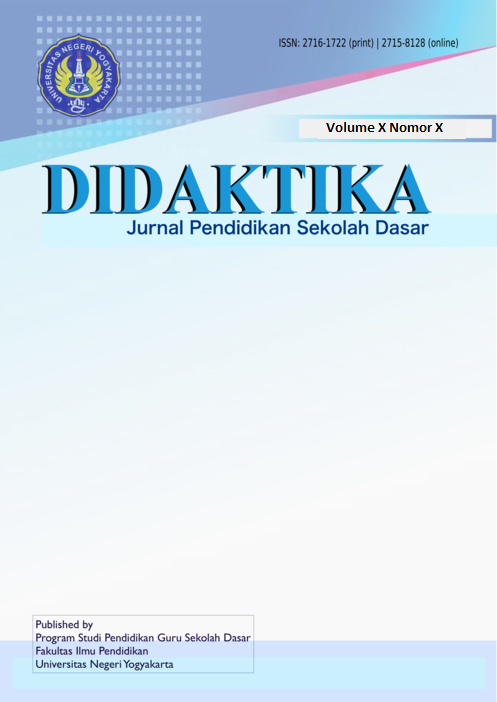Efektivitas Structure Learning Approach (SLA) untuk Meningkatkan Kompetensi Guru dalam Memandirikan Siswa SD yang terReject di Wilayah KKG Kapanewon Sleman
DOI:
https://doi.org/10.21831/didaktika.v5i2.53970Abstract
References
Aisa. (2015). Keefektifan Structured Learning Approach Untuk Meningkatkan Empati Siswa. Tesis tidak diterbitkan. Universitas Negeri Malang.
Bolger, K. E., & Patterson, C. J. (2001). Developmental pathways from child maltreatment to peer rejection. Child Development, 72(2), 549–568. https://doi.org/10.1111/1467-8624.00296
Dinata, A, N., Murtini, & Safaria, T. (2019). Peran peer acceptance dan perilaku assertif pada keterampilan sosial remaja. Prosiding Seminar Nasional Magister Psikologi Universitas Ahmad Dahlan, 327–334. http://seminar.uad.ac.id/index.php/snmpuad/article/download/3444/774
Goldstein, A. P., Sprafkin, R. P., Gershaw, N. J., & Klein, P. (1980). Skill Streaming the adolescent: A structured learning approach to teaching prosocial skills. Research Press Company.
Harvala, M. A. (1993). Classroom participation skills. ProQuest LLC.
Hurlock, E. B. (1978). Perkembangan Anak Jilid 1. Alih bahasa: Meita Sari Tjandrasa dan Muslichah Zarkasih. Erlangga.
Latifah, L. (2016). Pengembangan Buku Panduan Penyesuaian Diri di Lingkungan Kerja Menggunakan Metode Structured Learning Approach (SLA) Bagi Siswa SMK. Universitas Negeri Malang.
Lickona, T. (2013). Educating For Character (Terjemahan). Bumi Aksara.
McGrath, H., & Noble, T. (2010). Supporting positive pupil relationships: Research to practice. Educational and Child Psychology, 27(1), 79–90.
Santrock, J. W. (2011). Educational Psychologi 5th Edition. McGraw-Hill Companies.
Siregar, Y. E. Y., S, Z. M., W, P. A., Rachmadtullah, R., & Pohan, N. (2018). Self Regulation, Emotional Intelligence With Character Building In Elementary School. 251(Acec), 315–318. https://doi.org/10.2991/acec-18.2018.72
Sugiyono. (2016). Metode Penelitian Kuantitatif, Kualitatif dan R&D. Alfabeta.
Tusyana, E., Trengginas, R., & Suyadi. (2019). ANALISIS PERKEMBANGAN SOSIAL-EMOSIONAL TERCAPAI Abstrak. Jurnal Iventa, 3(1), 18–26. http://jurnal.unipasby.ac.id/index.php/jurnal_inventa/article/download/1804/1626
Wahyu, A., Ardyanti, T., Hitipeuw, I., & Ramli, M. (2017). Structured Learning Approach ( Sla ) Modification To Improve Sharing Skills of At-Risk Students. European Journal of Education Studies, 3(7), 361–376. https://doi.org/10.5281/zenodo.819481
Downloads
Published
How to Cite
Issue
Section
Citation Check
License
- Authors retain copyright and grant the journal right of first publication with the work simultaneously licensed under a Creative Commons Attribution License that allows others to share the work with an acknowledgement of the work's authorship and initial publication in this journal.
- Authors are able to enter into separate, additional contractual arrangements for the non-exclusive distribution of the journal's published version of the work (e.g., post it to an institutional repository or publish it in a book), with an acknowledgement of its initial publication in this journal.
- Authors are permitted and encouraged to post their work online (e.g., in institutional repositories or on their website) prior to and during the submission process, as it can lead to productive exchanges, as well as earlier and greater citation of published work.






